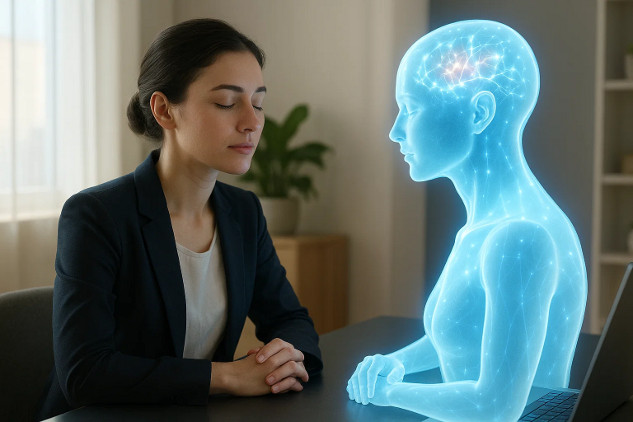
In This Article
- Can AI truly support your emotional well-being?
- What are the real-world benefits of using ChatGPT or Claude for mental health?
- Are AI chatbots a safe alternative to therapy?
- What dangers come with relying on AI for mental health?
- How can you safely integrate AI tools into your self-care?
Can AI Therapy Ease Your Anxiety or Depression?
by Robert Jennings, InnerSelf.comThere’s a reason people are turning to AI for emotional support, and it’s not just about convenience. Traditional therapy has become a luxury—more expensive than ever and less accessible to the average person. Waitlists stretch for months, insurance coverage is a bureaucratic maze, and many rural or underserved areas have few if any, mental health professionals.
AI tools like ChatGPT and Claude fill that vacuum with instant, always-available interaction. No appointments, no paperwork, no judgment. You can cry into your phone at 3 a.m., unload your spiraling thoughts, and receive what feels like a compassionate response. “That sounds really hard. I’m here for you,” says the bot. And in that moment, for some, it really does feel like someone is listening.
But let’s not confuse responsiveness with understanding. AI doesn’t actually know you. It doesn’t care because it can’t. It’s not conscious—it’s a prediction machine cobbled together from endless streams of online text. It was trained to mimic the tone of empathy by analyzing every psychology blog post, Reddit confession, and journal article it could scrape.
So when it “responds,” it’s not relating—it’s imitating. It sounds human because it was built to sound human, not because it feels what you feel. That doesn’t make it worthless—far from it. But we need to stay rooted in reality. An AI chatbot might provide temporary comfort or even useful tools, but let’s not hand over our emotional lives to something that can’t experience a single heartbeat of what we’re going through.
Comfort on Demand: The Real-World Benefits
To be fair, AI tools do bring some real benefits to the table—especially for those who often fall through the cracks of our overstretched mental health system. For people who feel isolated, unheard, or marginalized, even a simulated conversation can feel like a lifeline. When the walls are closing in, and there’s no one to talk to, a chatbot that’s available 24/7 can offer just enough support to keep someone from slipping further.
It doesn’t judge, doesn’t interrupt, and doesn’t get tired. AI can guide users through mindfulness prompts, offer breathing exercises, or suggest reframing techniques based on cognitive behavioral therapy. For someone stuck in a spiral of anxiety or depression, those small, accessible steps can make a big difference at the moment.
What also makes AI appealing is the sheer convenience and privacy it offers. There’s no need to navigate health insurance systems, fill out intake forms, or sit in a waiting room where everyone knows why you’re there. You don’t have to explain your background, disclose your trauma, or worry that a professional might misread your pain. It’s just you and your chatbot working through your late-night existential dread in digital solitude. For many, that anonymity is empowering. It strips away the social discomfort that often prevents people from seeking help in the first place.
In this sense, AI therapy can feel less like a clinical transaction and more like a low-stakes conversation—one where the fear of being misunderstood or judged is significantly reduced. That kind of emotional safety, even when simulated, opens doors for people who would otherwise stay silent.
It democratizes access to mental health tools, offering support to those in underserved communities, across income brackets, and even across cultural lines where stigma around therapy still lingers. While it’s no substitute for human empathy, it does offer a kind of bridge—a first step toward healing that might not have happened at all without it.
Emotional Band-Aid or New Dependency?
Here’s where the line starts to blur. While AI therapy can offer short-term comfort, it’s no replacement for the messy, reciprocal relationship of actual human healing. It doesn’t challenge your beliefs unless prompted. It won’t call you out when you’re deluding yourself. It can’t detect the subtle shifts in tone that signal more profound trauma or a hidden cry for help.
And let’s talk about overuse. What happens when someone starts relying on AI as their only confidant? We’ve already seen social media shape mental health in disturbing ways. Now imagine a vulnerable person offloading their pain to a machine that’s designed to say just enough to keep them coming back. That’s not therapy—that’s emotional vending. And while it might feel soothing, it can also lead to more profound isolation. This overreliance on AI for emotional support can be dangerous, leading to a deeper sense of loneliness and a lack of genuine human connection.
We’ve got to be honest: AI can be wrong. Sometimes spectacularly so. Ask it for medical advice, and it might hallucinate fake studies or suggest downright dangerous actions. That’s because it doesn’t understand the truth—it mimics patterns. Suppose the training data contains flawed or biased information (and let’s be clear, it does). In that case, the AI will regurgitate those flaws with confidence and fluency. For the best results on essential matters, check with another chat or source.
This becomes especially concerning in moments of crisis. If someone is suicidal, for example, an AI may not recognize the urgency or provide appropriate support. And while most systems have safety protocols, they’re far from foolproof. The illusion of empathy can be dangerous if it prevents people from seeking real help. In some cases, it could even cost lives.
Setting Boundaries: How to Use AI Wisely
So, how do we navigate this new emotional frontier without getting swallowed whole by glowing screens and synthetic empathy? First and foremost, we have to remember that AI is a tool—not a therapist. That means using it for what it’s good at, not what we wish it could be. Tools like ChatGPT and Claude can help organize your thoughts, offer mood journaling prompts, suggest relaxation exercises, or provide a place to vent when no one else is around.
They can support you, remind you to breathe, and even reflect your thoughts back to you in coherent, sometimes surprisingly insightful ways. But they aren’t licensed professionals, and they don’t have a soul. Don’t fall into the trap of treating your chatbot like a lifeline. It’s a companion at best—a helpful tool to keep in your mental health kit, not the entire toolbox.
Second, sharpen your sense of skepticism. If a response feels overly polished or conveniently agreeable, it probably is. These bots are trained to give you the “right” answer—or, at least, the one that sounds the most comforting or confident based on the data they've been fed. But sometimes, what we need isn’t comfort—it’s truth, challenge, or nuance. That’s where real people come in.
If you're facing a serious issue, don’t rely on AI to validate your experience or direct your next step. Run important decisions by trusted friends, family, or professionals who know you, not just your text history. And if you notice that AI is becoming more of a distraction than a help, that’s your cue to unplug and refocus. Mental health is too important to entrust to code alone.
Ultimately, we must push back against the growing tendency to suffer in isolation. Emotional pain is part of the human condition, and healing doesn’t happen in a vacuum. It occurs in connection—raw, awkward, beautiful human connection. Whether that’s sitting in a support group, talking to a friend, or sharing silence with a loved one who understands, those are the moments when healing takes root.
AI might give you language, comfort, or a sense of being heard, but it can’t offer the intimacy of being known. If anything, use it as a stepping stone—a gentle nudge toward reconnecting with the people and communities that make life worth living in the first place. Because in the end, no matter how smart our machines get, healing will always be a profoundly human act.
The Bottom Line: A Tool, Not a Therapist
AI therapy is neither savior nor villain—it’s a mirror, and like all mirrors, it only reflects what we bring to it. It doesn't heal us; it reveals patterns, echoes our words, and lends structure to our thoughts. When used thoughtfully, AI can be a helpful companion on the path to self-awareness. It can offer comfort in solitude, prompt us to reflect, and even motivate us to take small steps forward.
But let’s be clear: if we begin replacing our real-life relationships with digital simulations, we’re not moving into some enlightened future—we're backing into emotional isolation under the illusion of connection. No matter how fluent or empathetic the response, AI cannot replace the soul-to-soul resonance that occurs when another human being truly sees and hears us.
That said, there’s value in the access AI provides—especially for people who’ve long been shut out of the mental health system. We should absolutely celebrate its ability to open doors where none existed. But celebration must be tempered with vigilance. We have a responsibility to demand transparency from the people building these tools. Are the data sets diverse? Are the safeguards in place?
Are these systems designed to help people—or just to keep them engaged? These are not just technical questions; they’re moral ones. Because at the end of the day, healing isn’t about feeling better in the moment—it’s about building a life rooted in truth, connection, and authenticity. And that still requires something no machine can provide: each other.
About the Author
 Robert Jennings is the co-publisher of InnerSelf.com, a platform dedicated to empowering individuals and fostering a more connected, equitable world. A veteran of the U.S. Marine Corps and the U.S. Army, Robert draws on his diverse life experiences, from working in real estate and construction to building InnerSelf with his wife, Marie T. Russell, to bring a practical, grounded perspective to life’s challenges. Founded in 1996, InnerSelf.com shares insights to help people make informed, meaningful choices for themselves and the planet. More than 30 years later, InnerSelf continues to inspire clarity and empowerment.
Robert Jennings is the co-publisher of InnerSelf.com, a platform dedicated to empowering individuals and fostering a more connected, equitable world. A veteran of the U.S. Marine Corps and the U.S. Army, Robert draws on his diverse life experiences, from working in real estate and construction to building InnerSelf with his wife, Marie T. Russell, to bring a practical, grounded perspective to life’s challenges. Founded in 1996, InnerSelf.com shares insights to help people make informed, meaningful choices for themselves and the planet. More than 30 years later, InnerSelf continues to inspire clarity and empowerment.
Creative Commons 4.0
This article is licensed under a Creative Commons Attribution-Share Alike 4.0 License. Attribute the author Robert Jennings, InnerSelf.com. Link back to the article This article originally appeared on InnerSelf.com
books_health
Article Recap
AI therapy is changing how people deal with anxiety and depression. While tools like ChatGPT and Claude offer accessible and affordable emotional support, they come with real risks—misinformation, overdependence, and emotional disconnect. Used wisely, they can be a helpful supplement, but never a full substitute for genuine human connection and professional care.
#AITherapy #MentalHealthSupport #ChatGPTHelp #ClaudeAI #AIAnxietyHelp #DigitalTherapist #AnxietyRelief #DepressionSupport



